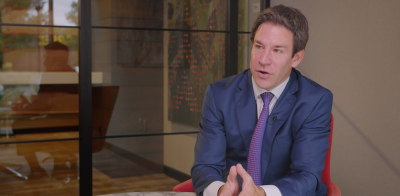As painful as it may be for investors who clung to the 60/40 asset allocation model for too long (down -16.1% in 2022!) and as further support for those who fought inertia and embraced democratized alternatives, we believe it makes sense to at least quickly recap 2022 to better inform future asset allocation decisions (those who do not learn from history are doomed to repeat it).
- In case you pulled a Rip Van Winkle in the last 12 months, you probably already know 2022 was a complete trainwreck for financial assets. The S&P 500 finished down -18.1% and the Barclay’s Agg finished down -13%. The hit to classic 60/40 portfolios far exceeded the toast treatment and was turned to charcoal—down a whopping 16.1%. As you have read, there are various terms to describe the current environment: Hangover from excessive returns of 2020 and 2021, or Galactic Mean Reversion over longer time horizons, or for you optimists out there, a sloppy, choppy mess. You know things have been rough for 60/40 when choppy, sloppy mess is the optimistic take!
- The proximate causes of the great financial asset implosion of 2022 were:
- Valuations entered the year at close to record high levels
- The S&P 500: Entered the year at 21.2X consensus forecast 2022 earnings, close to a record high only exceeded by the 25x of the dot-com bubble glory years.
- Ten-year Treasury yield: At 1.51%, duration/interest rate sensitive fixed income1 was indeed the definition of return-free risk coming into 2022.
- Excessive fiscal and monetary stimulus: From the acute stages of the pandemic through at least March of 2022, Russia’s horrific invasion of Ukraine, and China’s self-immolating and counterproductive zero-COVID policy drove the highest levels of real economic inflation in over 40 years (instead of the more typical financial asset inflation of the prior 13 years), which in turn led to…
- Nominal GDP (economic growth including inflation) dwarfing real GDP (economic growth excluding inflation).
- A Fed that had been asleep at the wheel: They were borderline delusional in describing inflation as “transitory” as recently as late November 2021, and bizarrely continued quantitative easing through the first quarter of 2022 after admitting they were wrong on inflation (even more of a head scratcher), finally launched the most aggressive Fed hiking (monetary policy/financial condition tightening) campaign in history:
- 425 basis points of hikes in 10 months including four 75 bps whoppers.
- A Quantitative Tightening/Balance Sheet Reduction program that progressed at 2.56x the size of the last one in 2017 and 2018 in terms of dollars, 2.06x in terms of nominal GDP and 1.76x in terms of existing money supply. The Fed actually promised to move at almost twice this pace given how concerned they have recently become with inflation. There are certainly good logistical reasons why they have moved more slowly (such as the extension of Agency RMBS duration/maturity due to higher interest rates). However, once again words and deeds from the Fed have differed materially. Then again, despite all the vitriol thrown at the Fed from the permabull crowd for tightening too fast or not being patient enough with the lagging impact between tightening and constraining inflation, they have actually been pretty deliberate not to let Quantitative Tightening2 cause a financial market Armageddon.
- Money supply contraction: This happened at a record pace (5.1% annualized the past three months through November) after the record 42% expansion, post-pandemic.
- Multiple compression: Money supply contraction helped drive substantial multiple compression in equity markets (from 21.2x coming into the year to 16.6x going into 2023 based on questionable 5% earnings growth in 2023).3
- Skyrocketing bond yields: And, of course, bond yields skyrocketed from exceptionally low levels (10-year Treasury Yield up from 1.51% coming into 2022 to 4.25% for a picosecond in October, and back down to 3.88% by year end).
- Worst stock/bond market of recent times: All of this drove the worst simultaneous fixed income and equity market outcomes (Barclay’s Agg down -13%, S&P 500 down -18.1%) in living memory.
- Resilient labor: Yet through it all, the labor market remained incredibly resilient.
- Galactic Mean Reversion: Again, one of the best ways to think of this is as a Galactic Mean Reversion between financial assets, the real economy and the labor market.
- The economy grew? Last we checked, the economy expanded in 2022 (albeit at a modest rate measured in real terms but much more strongly in nominal terms).
- Labor market also strong: Last we checked, the labor market ended 2022 (at least through November) in remarkably good shape with the unemployment rate close to a record low at 3.7% and close to record high ratio of 1.72 of job openings to unemployed workers.
- The flip side: 2022 was basically the complete opposite market environment of April 2020 through the end of 2021 (greenlight go) and instead started the year at yellow light caution, and rapidly turned to orange light extra caution once Russia invaded Ukraine and the Fed announced its quantitative tightening program.
- Valuations entered the year at close to record high levels
- Now before we turn to our outlook for 2023, let’s not forget to be thankful for the two brightest silver linings in the current stormy environment.
- Crisis is unlikely: The risk of another global financial crisis is still incredibly low primarily due to regulatory reform and a more risk averse, utility-like culture in the U.S. banking system.
- The U.S. banking system still has almost $3.126 trillion (that’s trillion with a T) in excess reserves compared to $10 billion going into the global financial crisis.
- U.S. banking system Tier I Capital or loan loss absorption capability has more than doubled where it was going into the global financial crisis in terms of dollars and is 50% higher in terms of common equity to risk weighted assets.
- Underwriting standards, particularly for residential and commercial real estate loans, have been much tighter than the bad old days of the 2004 to 2006 anything goes era of irresponsible lending (Can you fog a mirror? Here’s a 110 LTV reverse amortizing subprime mortgage for you!)
- Alternative investments are now democratized: The majority of individual investors have far more tools at their disposal to negotiate the current market environment than the Eurozone crisis, the global financial crisis and the dot-com bubble implosion.
- Crisis is unlikely: The risk of another global financial crisis is still incredibly low primarily due to regulatory reform and a more risk averse, utility-like culture in the U.S. banking system.
- We’ll keep the 2023 outlook short and sweet. The time for the right alts is (still) now: Expect more of the same from 60/40 in 2023 (but probably less pain for bonds) because we’re still in orange light extra caution territory.
- Galactic Mean Reversion to continue: All three factors that drove outrageous levels of financial asset and all asset outperformance for a long time are now going the other way…hard AND fast.
- Interest rates: At least temporarily going higher in the front end of the yield curve (lowered borrowing costs and the low interest rate justifications for high asset valuations is over).
- Money supply growth: Sustained post-global financial crisis M24 growth well above nominal GDP capped off by the 42% post-pandemic surge is over and going the other way as far as the eye can see.
- Globalization: We’re now deep into a deglobalization period, particularly with regard to China’s labor market. The disinflationary impact of China’s labor pool (one of the major reasons the Fed struggled to get inflation to 2% for so long) as well as globalization’s role in driving S&P profit margins from 5% to 6% when China entered the World Trade Organization to 12% to 14% more recently is over and is going the other way fast.
- Remember, we’ve had these periods before: They are nothing new or revolutionary. They tend to be long and drawn out like 1964 to 1982 or 2000 through 2009. They don’t magically end based on hope.
- Economy: The good news is that month by month, quarter by quarter, the U.S. economy will gradually escape this inflationary period. The bad news is the price the U.S. economy will pay for this great escape is a mild recession (at least a mild one, possibly worse). Since the majority of excess savings from the pandemic have been spent by the lower six to eight income deciles, the savings rate has dropped to close to a record low of 2.3% (most if not all being saved by the top income decile), real disposable personal income is down by -2.5% over the last year, and withholding tax collections down to 1.2% year over year (well below 7.1% CPI), financial assets and now the residential housing market suffering substantial losses, and interest rates have gone up A LOT REALLY FAST, the U.S. consumer/worker’s ability to drive consumption and economic growth will end once the labor market finally cracks (as a reminder, that is now official Fed policy). However, given the continued strength of the labor market (1.7 job openings per unemployed worker, 3.7% unemployment rate), the soonest we could see a recession begin is late in the second quarter of this year and the latest is the first quarter of 2024.
- Equities: We expect the Galactic Mean Reversion to continue with more modest multiple compression for equities in the near term (relative to 2022). We expect equity markets to make at least one more lower low in price driven by continued tightening of monetary policy. After that, equities should make a final low driven by an eventual decline in earnings principally driven by profit margin compression and the upcoming recession. If we’re wrong, the upside surprise is a choppy, sloppy mess, which really isn’t much of an upside surprise at all, is it? Don’t overthink it with false precision or timing…equities are going down and we would be surprised if a 30% to 40% peak to trough decline from the January 2022 highs does not occur.
- Fixed income: Reasonable, rational people can disagree over whether yields have actually peaked this cycle or not. If the economy slips into recession sooner rather than later, it is possible that yields peaked in October 2022. However, given the continued strength of the labor market, a Federal Reserve that wants tighter financial conditions (including higher bond yields), a Fed Funds rate headed to at least 5% if not higher, and continued muscular quantitative tightening, we believe it is more likely that yields make at least one more higher high and duration sensitive fixed income has one more round of pain. If we’re wrong and yields have peaked, the income generated from duration risk might not be as insulting as it was coming into 2022, but is certainly nothing to get excited about!
- Real estate: One of the greatest bull markets in history has now turned into a correction due to higher borrowing costs/mortgage rates and higher cap rates. Fortunately, I expect only a 10% to 25% decline depending on region, sector, residential versus commercial, etc., and this will be a price/valuation problem and not a credit problem. In the big picture, no big deal for the financial system since it is unlikely real estate prices revert to even pre-pandemic levels let alone below that. Some of the excessive gains of 2020 and 2021 will evaporate and longer-term returns will normalize. Life goes on…but make sure you’re senior in the capital structure! We’ll say it again: Unless you’re into losing money in real estate equity investments on a mark-to-market basis the next several years, try to roll up the capital structure! Why lose money if you don’t have to? Be the bank, not the bricks!
- Credit: Credit spreads have remained remarkably resilient so far but will inevitably head wider next year. It would be stunning if high yield spreads don’t hit at least hit 600 to 800 and probably gap wider than that for a short period of time. However, given generally improved underwriting and expectations for lower peak default rates, the wides in spreads should be tighter than the 2000 to 2002 cycle and the global financial crisis. In the meanwhile, the cash flow/income can help mitigate mark-to-market losses and realized defaults. And if we’re wrong on our market views, credit may provide a degree of upside capture depending on the sector/strategy.
- Future bull market potential
- Don’t expect one anytime soon
- The next Fed cutting cycle will be a close to mirror image of the last hiking cycle…a glacially slow and methodical pace.
- There will be no quantitative easing to bail out markets anytime soon unless markets collapse and unemployment skyrockets.
- The next bull market will be a more stable, less manipulated period of gains similar to October 2002 to October 2007 driven by earnings growth and not by earnings growth AND massive multiple expansion (from 9x to 21x in the last bull market—multiples more than doubled!)
- Galactic Mean Reversion to continue: All three factors that drove outrageous levels of financial asset and all asset outperformance for a long time are now going the other way…hard AND fast.
- Feel free to ignore everything just stated and solely focus on the golden rule of risk appetite/risk taking and then allocate wisely.
- Whenever money supply (M2) grows slower than nominal GDP, it is hard for markets to go up.
- Whenever money supply grows faster than nominal GDP, it is hard for markets to go down.
- Guess what? Money supply is contracting while nominal GDP is still in the high single digits and with the Fed targeting a balance sheet reduction of approximately 35% (with only 4.6% complete so far)…look out below.
In closing, 2023 will look a lot like 2022 for markets, probably just not quite as bad (for fixed income at least)…so fight inertia, embrace the right democratized alternatives that seek to deliver better risk-adjusted returns for yourself or your investors!
Investing in alternatives is different than investing in traditional investments such as stocks and bonds. Alternatives tend to be illiquid and highly specialized. In the context of alternative investments, higher returns may be accompanied by increased risk and, like any investment, the possibility of an investment loss. Investments made in alternatives may be less liquid and harder to value than investments made in large, publicly traded corporations. When building a portfolio that includes alternative investments, financial professionals and their investors should first consider an individual’s financial objectives. Investment constraints such as risk tolerance, liquidity needs and investment time horizon should be determined.



